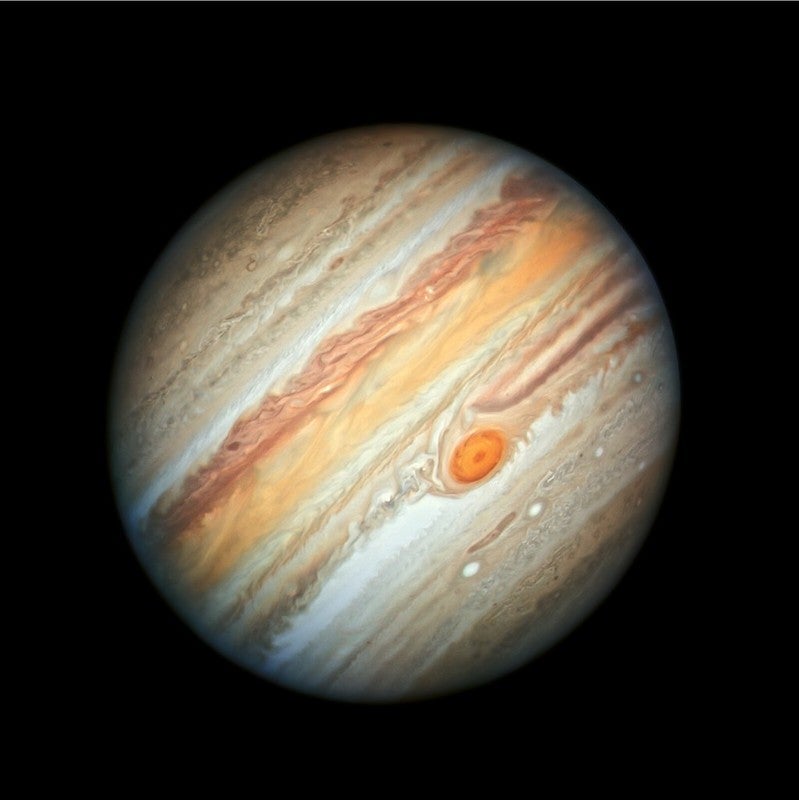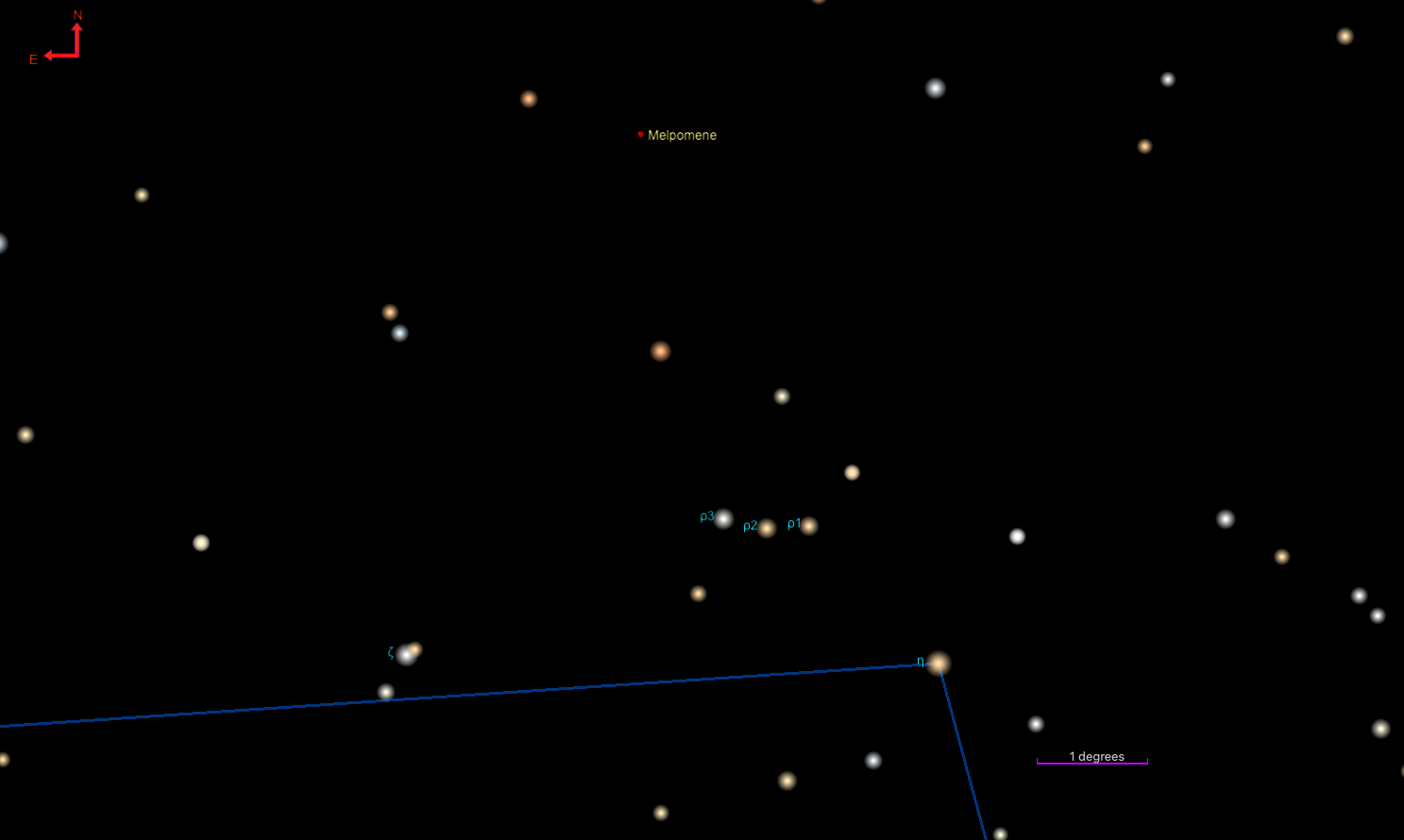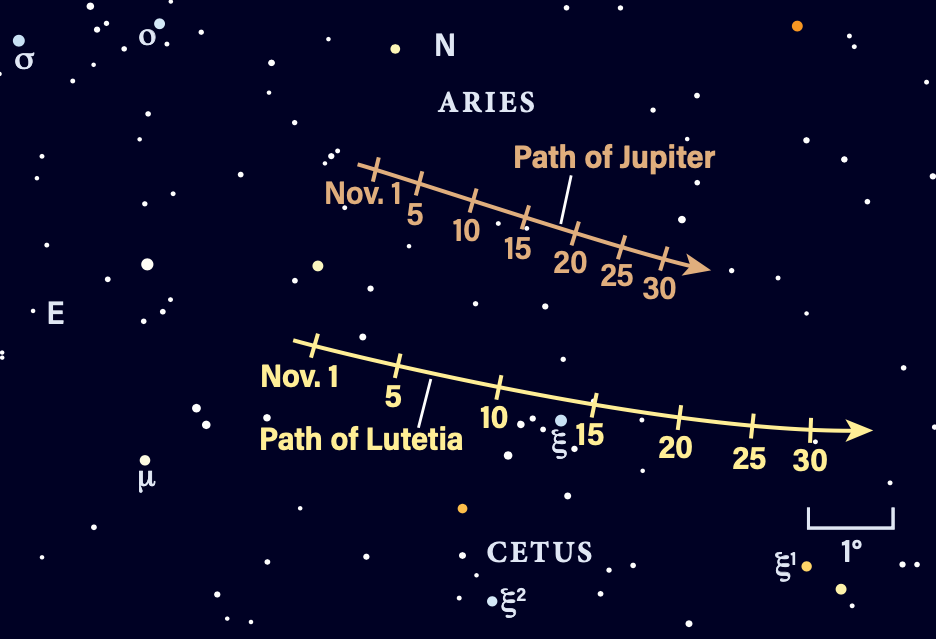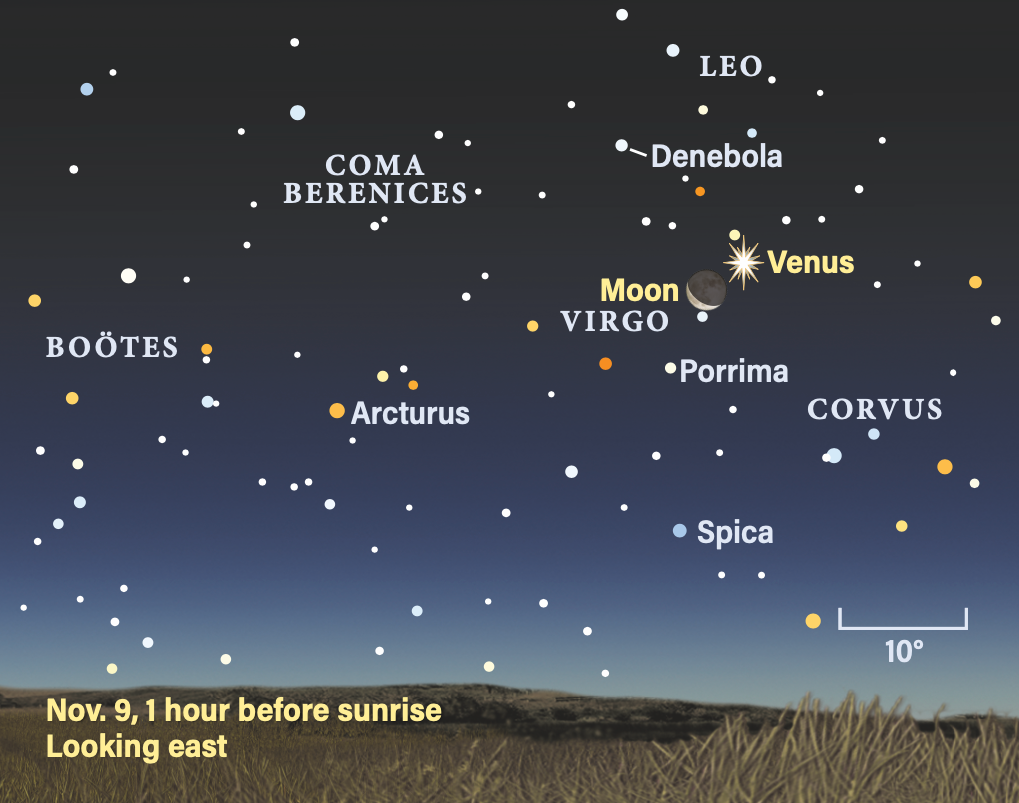
Friday, November 3
Jupiter reaches opposition at 1 A.M. this morning, putting its best and brightest face forward for observing. Rising roughly as the Sun is setting this evening, you’ll find magnitude–2.9 Jupiter in the east, dominating the dim constellation Aries. By about two hours after sunset, Jupiter is more than 20° high, located to the far upper right of the easily recognizable Pleiades star cluster in nearby Taurus.
This is the best time of the year to view Jupiter. It’s up all night, so anytime you can get out to take a look, give it a go. Aim a telescope up to check out the gas giant’s 49″-wide disk, rife with detail. Even low-powered scopes will likely pick up on the alternating light and dark cloud belts that encircle the planet. The Great Red Spot, a huge, Earth-sized storm that has been raging for hundreds of years, is also visible tonight. It will be crossing the central meridian of the planet around 8:15 P.M. EDT and should be easy to pick out for at least an hour and a half before and after that time.
But there’s something else you might see crossing the cloud tops: The Galilean moon Europa begins a transit at 9:15 P.M. EDT, moving from east to west. Its shadow, projected onto the cloud tops below, is all but indistinguishable from the moon. That’s because, thanks to the geometry of the Sun, Earth, and Jupiter while the latter is at opposition, the moons and their shadows appear to transit at the same time. In exactly one week, Europa will transit again — we’ll return then to see how things have changed.
Sunrise: 7:31 A.M.
Sunset: 5:56 P.M.
Moonrise: 10:38 P.M.
Moonset: 1:33 P.M.
Moon Phase: Waning gibbous (66%)
*Times for sunrise, sunset, moonrise, and moonset are given in local time from 40° N 90° W. The Moon’s illumination is given at 12 P.M. local time from the same location.
Saturday, November 4
Saturn is stationary at 1 P.M. EDT against the stars of Aquarius the Water-bearer. The ringed planet was previously moving west, or retrograde; now it will pause and, over the next few days, slowly begin moving prograde, or east, compared with the distant background of stars.
You’ll find Saturn, our solar system’s other gas giant, due south around 10 P.M. local daylight time. (Note: This is the last night that will be true if you live in an area that observes daylight saving time, which ends early tomorrow morning!) It glows at magnitude 0.7, much fainter than Jupiter in the east but still outshining any stars nearby.
Saturn is, of course, best known for the stunning rings that surround it. You can enjoy these through any telescope, stretching some 40″ wide and 6″ across their narrower axis. The disk of the planet itself is about half as wide, roughly 18″. Saturn’s largest and brightest moon, Titan, lies just southeast of the planet tonight, glowing around 8th magnitude. You may spot it even in low-powered scopes or binoculars. Much more difficult to see is tiny, 10th-mangitude Tethys, which reappears close to Saturn’s northeastern limb around 11:20 P.M. EDT after crossing first behind the planet and then moving through its shadow, which similarly stretches behind Saturn to the northeast from our current point of view. Over time, Tethys will slowly pull away from the brighter planet and its rings as it moves farther east, which should aid in its identification.
Sunrise: 7:33 A.M.
Sunset: 5:54 P.M.
Moonrise: 11:42 P.M.
Moonset: 2:10 P.M.
Moon Phase: Waning gibbous (56%)

Sunday, November 5
Daylight saving time officially ends this morning at 2 A.M. local daylight time, when clocks “fall back” an hour to 1 A.M. standard time. Note that this will change the times of sunrise and sunset, moonrise and moonset, as well as the times the planets will pass certain points in the sky. (Of course, nothing about the Sun, Moon, or planets actually changes — it’s that our local time has changed!)
Last Quarter Moon also occurs this morning at 3:37 A.M. EST — note the time has switched over to standard in some but not all U.S. time zones by this time..
Later today, asteroid 18 Melpomene reaches opposition at 10 P.M. EST. At 8th magnitude, you can capture this main-belt world easily in binoculars or a telescope. It’s located in northwestern Eridanus, near a small curve of 5th-magntude stars: Rho1 (ρ1), Rho2 (ρ2), and Rho3 (ρ3) Eridani. These three stars sit near brighter, 4th-magnitude Eta (η) Eridani. Locate the latter star, then look about 2° east-northeast to find the three-star curve. From the trio of Rho stars, look about 3.7° north-northeast to find Melpomene. Don’t confuse it for a slightly brighter 6th-magnitude field star about 1° to its northeast. Melpomene is the fainter dot to the star’s southwest.
Sunrise: 6:34 A.M.
Sunset: 4:53 P.M.
Moonrise: 11:44 P.M.
Moonset: 1:39 P.M.
Moon Phase: Waning crescent (47%)
Monday, November 6
The Moon reaches apogee, the farthest point from Earth in its orbit, at 4:49 P.M. EST. At that time, our satellite will sit 251,388 miles (404,570 kilometers) away.
Let’s return to Jupiter in Aries tonight to watch the planet’s largest moon, Ganymede, undergo an interesting eclipse. Check in with the planet starting around 10:30 P.M. EST, when Jupiter is some 50° high in the southeast. You’ll see Ganymede sitting just off the planet’s northwestern limb, near the pole. Keep watching — starting around 10:40 P.M. EST or so, the moon’s light will begin to blend with that of the planet’s limb. Around 10:44 P.M. EST, the moon should disappear fully; it will then cross behind the planet from our point of view and re-emerge on the northeastern limb just before midnight EST.
But there’s a catch: Even once Ganymede has cleared the planet, it’s still deep in Jupiter’s long shadow. It takes nearly 30 minutes more for it to clear that — observers should see Ganymede reappear around 12:16 A.M. EST on the 7th (still the 6th in all other U.S. time zones); once again taking several minutes to fully appear.
While Ganymede is making this trip, you can also spot Io alone to the planet’s west, and Callisto and Europa to the east. Callisto lies north and slightly east of Europa and is moving east; Europa is moving west, toward the planet.
Sunrise: 6:34 A.M.
Sunset: 4:52 P.M.
Moonrise: —
Moonset: 2:05 P.M.
Moon Phase: Waning crescent (38%)

Tuesday, November 7
It’s back to Jupiter again tonight! But this time it’s to use the bright planet as a signpost to find the fainter asteroid 21 Lutetia, which is carving a similar path through the sky just to the south of Jupiter.
Find Jupiter in the east an hour or two after sunset. Then use binoculars or a telescope to center the planet and drop 2.2° due south — there’s Lutetia. This main-belt asteroid was discovered in 1852 and visited by ESA’s Rosetta mission in 2010. It measures roughly 60 miles (100 kilometers) across and shines around 10th magnitude in our skies. That means you’ll be best served in finding it by larger binoculars or a small scope, as well as a bit of patience. Use the star chart above and take advantage of Jupiter’s position due north of Lutetia to help you identify it. Do note that depending on your optics, your view might be rotated or flipped from the one shown.
As you can also see from the chart, Lutetia is moving westward at a good clip, covering slightly more of the sky than Jupiter this month. That’s because Lutetia, in the main belt, is slightly closer to us. Compare the view night after night for several days or even weeks to find the moving spot and track the asteroid as it moves against the stationary background stars.
Sunrise: 6:36 A.M.
Sunset: 4:51 P.M.
Moonrise: 12:46 A.M.
Moonset: 2:27 P.M.
Moon Phase: Waning crescent (29%)
Wednesday, November 8
There are several good binocular comets in the sky right now, so let’s pick one! Comet C/2023 H2 (Lemmon) is currently the brightest, recently observed at magnitude 7.9. Now flying through Hercules, Lemmon is highest at sunset and slowly sinks in the west as the hours go by. So, catching it earlier in the evening is best, starting around an hour or two after sunset. The comet will set just before 11 P.M. local time, but note that the lower it gets, the more difficult it will be to observe, as we’re looking through more of Earth’s atmosphere as objects approach the horizon. The air near the ground is also more turbulent than air higher up, which causes objects to appear to shimmer and shift in the sky.
You’ll find Lemmon just under 6° southwest of 4th-magnitude Theta (θ) Herculis, in a small area with few nearby field stars of similar brightness. Through binoculars or a telescope, the comet should appear as a softly glowing ball of fuzz. Photos will bring out its greenish hue, due to diatomic carbon released from the nucleus, and perhaps a thin tail still streaming away from the comet.
Note that because Lemmon is close to Earth, it’s moving quickly through the sky. In fact, it appears to shift by the hour, moving roughly ¼° southeast per hour. The position we give above relative to Theta Herculis is at 8 P.M. EST. For each hour earlier you look, glance ¼° northwest of that position. For each hour later, look ¼° southeast of it. Around 9:30 P.M. EST, the comet sits roughly 0.1° south of a magnitude 6.6 field star (HD 160507).
Lemmon only recently rounded the Sun, reaching perihelion — the closest point to the Sun in its orbit — on October 29. Now, as it heads back to the outer solar system from whence it came, it is currently passing close to Earth (its closest approach is on the 10th) and brightening quickly. Some sources estimate it could even reach the edge of naked-eye brightness, around 5th magnitude! Because comets change quickly and we write this column ahead of time, it may even be quite bright by the time you read this entry. We’ll be keeping an eye on it!
Sunrise: 6:37 A.M.
Sunset: 4:50 P.M.
Moonrise: 1:46 A.M.
Moonset: 2:47 P.M.
Moon Phase: Waning crescent (20%)

Thursday, November 9
Let’s spend a little time with the morning sky as the Moon passes 1° north of Venus at 4 A.M. EST. At that time, the pair is only visible to those in the eastern half of the U.S., and still quite low in the Midwest.
Regardless of your location, around 4 A.M. local time the two are some 12° high in the east, amid the stars of Virgo. They continue to rise as the morning progresses and, by an hour before sunrise, stand roughly 30° high some 22° above the bright star Spica. Venus, at magnitude –4.3, is unmissable to the upper right of the delicate waning crescent Moon. Look for earthshine on the shadowed portion of the lunar surface — this effect occurs when sunlight bouncing off Earth lights up the darkened regions of the Moon already in lunar night.
Above Virgo lies the constellation Leo the Lion. The tip of the lion’s tail, Denebola, appears in the upper right region of the chart above; the body of Leo stretches to the upper right of this star in the sky as it rises. The big cat’s head is outlined by the Sickle asterism, which many envision as a backwards-facing question mark anchored at the bottom by Leo’s alpha star, magnitude 1.4 Regulus.
Leo is home to the Leonid meteor shower, which peaks overnight November 17/18. The shower’s activity officially began the 6th and is slowly ramping up toward that peak. So, if you’re out early this morning and have a little luck on your side, you may notice slightly more than the usual number of random meteors streaking across the sky.
Sunrise: 6:38 A.M.
Sunset: 4:49 P.M.
Moonrise: 2:46 A.M.
Moonset: 3:07 P.M.
Moon Phase: Waning crescent (13%)
Friday, November 10
Let’s close out the week with — you guessed it! — Jupiter again, this time to observe another transit of Europa and its shadow to see how things have changed since the date of opposition.
Now we get to see the real effects of solar system geometry at play. Earth has moved in its orbit by about 7°, which means moons and their shadows no longer transit simultaneously from our point of view. This should be evident as Europa slips onto the jovian disk from the east around 10:29 P.M. EST. This time, it appears alone — it takes 22 minutes before the small, dark blot of its shadow appears, slowly following the moon across the cloud tops from a respectable distance. Europa’s transit continues until just minutes before 12:45 A.M. EST on the 11th (still late on the 10th in all other U.S. time zones); its shadow finally disappears shortly after 1:10 A.M. EST (now the 11th in the Eastern and Central time zones, but the 10th farther west).
This time, Callisto lies alone to Jupiter’s east once Europa begins transiting, while Io (closest) and Ganymede (farther out) are to the planet’s west.
Sunrise: 6:39 A.M.
Sunset: 4:48 P.M.
Moonrise: 3:47 A.M.
Moonset: 3:28 P.M.
Moon Phase: Waning crescent (7%)

Sky This Week is brought to you in part by Celestron.









